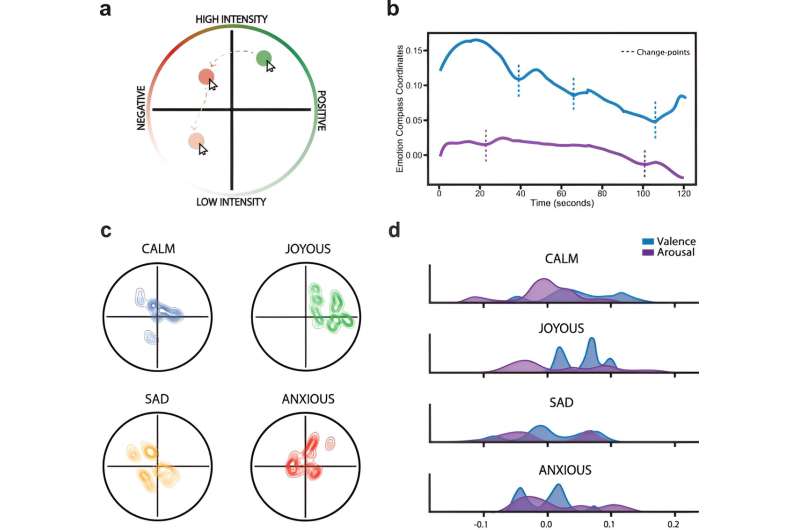This article has been reviewed according to Science X's editorial process and policies. Editors have highlighted the following attributes while ensuring the content's credibility:
fact-checked
peer-reviewed publication
trusted source
proofread
Why emotions stirred by music create such powerful memories

Time flows in a continuous stream—yet our memories are divided into separate episodes, all of which become part of our personal narrative. How emotions shape this memory formation process is a mystery that science has only recently begun to unravel. The latest clue comes from UCLA psychologists, who have discovered that fluctuating emotions elicited by music help form separate and durable memories.
The study, published in Nature Communications, used music to manipulate the emotions of volunteers performing simple tasks on a computer. The researchers found that the dynamics of people's emotions molded otherwise neutral experiences into memorable events.
"Changes in emotion evoked by music created boundaries between episodes that made it easier for people to remember what they had seen and when they had seen it," said lead author Mason McClay, a doctoral student in psychology at UCLA. "We think this finding has great therapeutic promise for helping people with PTSD and depression."
As time unfolds, people need to group information, since there is too much to remember (and not all of it useful). Two processes appear to be involved in turning experiences into memories over time: The first integrates our memories, compressing and linking them into individualized episodes; the other expands and separates each memory as the experience recedes into the past. There's a constant tug of war between integrating memories and separating them, and it's this push and pull that helps to form distinct memories. This flexible process helps a person understand and find meaning in their experiences, as well as retain information.
"It's like putting items into boxes for long-term storage," said corresponding author David Clewett, an assistant professor of psychology at UCLA. "When we need to retrieve a piece of information, we open the box that holds it. What this research shows is that emotions seem to be an effective box for doing this sort of organization and for making memories more accessible."
A similar effect may help explain why Taylor Swift's "Eras Tour" has been so effective at creating vivid and lasting memories: Her concert contains meaningful chapters that can be opened and closed to relive highly emotional experiences.
McClay and Clewett, along with Matthew Sachs at Columbia University, hired composers to create music specifically designed to elicit joyous, anxious, sad or calm feelings of varied intensity. Study participants listened to the music while imagining a narrative to accompany a series of neutral images on a computer screen, such as a watermelon slice, a wallet or a soccer ball. They also used the computer mouse to track moment-to-moment changes in their feelings on a novel tool developed for tracking emotional reactions to music.
Then, after performing a task meant to distract them, participants were shown pairs of images again in a random order. For each pair, they were asked which image they had seen first, then how far apart in time they felt they had seen the two objects. Pairs of objects that participants had seen immediately before and after a change of emotional state—whether of high, low, or medium intensity—were remembered as having occurred farther apart in time compared to images that did not span an emotional change.
Participants also had worse memory for the order of items that spanned emotional changes compared to items they had viewed while in a more stable emotional state. These effects suggest that a change in emotion resulting from listening to music was pushing new memories apart.
"This tells us that intense moments of emotional change and suspense, like the musical phrases in Queen's "Bohemian Rhapsody," could be remembered as having lasted longer than less emotive experiences of similar length," McClay said. "Musicians and composers who weave emotional events together to tell a story may be imbuing our memories with a rich temporal structure and longer sense of time."
The direction of the change in emotion also mattered. Memory integration was best—that is, memories of sequential items felt closer together in time, and participants were better at recalling their order—when the shift was toward more positive emotions. On the other hand, a shift toward more negative emotions (from calmer to sadder, for example) tended to separate and expand the mental distance between new memories.
Participants were also surveyed the following day to assess their longer-term memory, and showed better memory for items and moments when their emotions changed, especially if they were experiencing intense positive emotions. This suggests that feeling more positive and energized can fuse different elements of an experience together in memory.
Sachs emphasized the utility of music as an intervention technique.
"Most music-based therapies for disorders rely on the fact that listening to music can help patients relax or feel enjoyment, which reduces negative emotional symptoms," he said. The benefits of music-listening in these cases are therefore secondary and indirect. Here, we are suggesting a possible mechanism by which emotionally dynamic music might be able to directly treat the memory issues that characterize such disorders."
Clewett said these findings could help people reintegrate the memories that have caused post-traumatic stress disorder.
"If traumatic memories are not stored away properly, their contents will come spilling out when the closet door opens, often without warning. This is why ordinary events, such as fireworks, can trigger flashbacks of traumatic experiences, such as surviving a bombing or gunfire," he said. "We think we can deploy positive emotions, possibly using music, to help people with PTSD put that original memory in a box and reintegrate it, so that negative emotions don't spill over into everyday life."
More information: Mason McClay et al, Dynamic emotional states shape the episodic structure of memory, Nature Communications (2023). DOI: 10.1038/s41467-023-42241-2




















